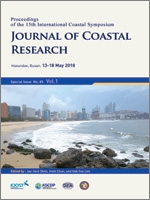Jing, L.; Kong, J.; Wang Q., and Yao Y.T., 2018. An improved contaminant source identification method for sudden water pollution accident in coaster estuaries, China. In: Shim, J.-S.; Chun, I., and Lim, H.S. (eds.), Proceedings from the International Coastal Symposium (ICS) 2018 (Busan, Republic of Korea). Journal of Coastal Research, Special Issue No. 85, pp. 946–950. Coconut Creek (Florida), ISSN 0749-0208.
This paper presents a method for quickly and accurately identifying contaminant source in estuary region, characterized by decoupling solving releasing time, location and density of source problems, respectively. The method firstly gets the rough source releasing time by analyzing the typical double peak phenomenon in tidal estuary region, and then presents the rough position of source by using Lagrange tracing scheme. The rough position makes up the deficiency of priori information in traditional Genetic Algorithm (GA). And then, according to the correlation between the measured and calculated concentration at measuring point, a high resolution mass transportation and an optimization models are operated repeatedly and alternatively. In order to increase the efficiency of searching optimal parameters, the Genetic Algorithm is improved by introducing a weighting factor based on the precision improvement trend. Such an optimization model can effectively reduce the calculation burden when parameters are increased in demand. This model has been successfully applied in an accident case in Quanzhou Bay of China. Simulated results confirm the model's merits in reasonably identifying relevant unknown parameters. The convergence of present model is more efficient in searching for the optimal parameters with less iteration times nearly half the traditional Genetic Algorithm. This model is high efficiency and has great practical significance in dealing with emergent water pollution in estuary and coastal areas.





